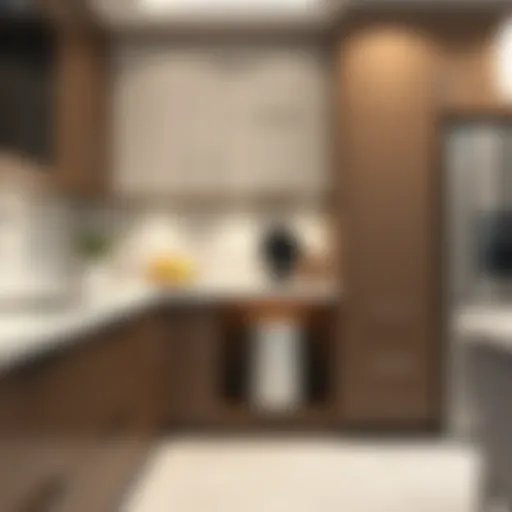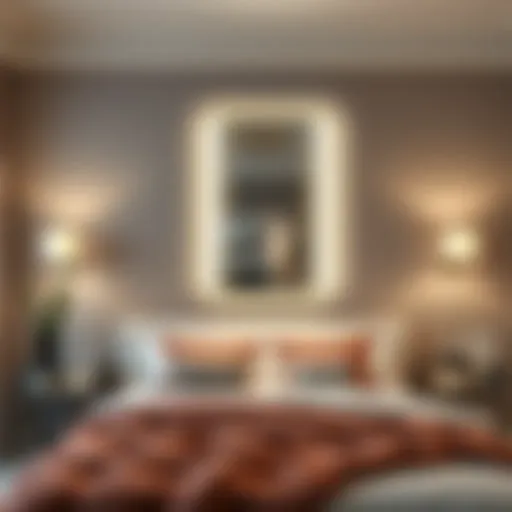Maximizing Kitchen Space with Shelving Solutions


Intro
In the hustle and bustle of daily life, kitchen space often becomes a premium. Between the fridge and the wall lies a narrow gap that is usually neglected, gathering dust rather than serving a purpose. However, this often-overlooked area holds potential for storage, organization, and even a bit of style. This article takes a closer look at how incorporating shelving between your refrigerator and wall can not only increase functionality but also breathe a bit of life into your kitchen.
Furniture Design Insights
Understanding Style Preferences
When considering a shelf for the gap between your fridge and wall, it’s essential to reflect on the overall style of your kitchen. Different styles call for different aesthetics. For instance, if your kitchen boasts a modern vibe, a sleek metal or glass shelf may fit right in. On the other hand, if your kitchen has rustic charm, floating wooden shelves can enhance its cohesive look. Users might also explore options like open shelving for easy access to frequently-used items.
A few style considerations include:
- Material choices: Wood, metal, or plastic, depending on durability and compatibility with your kitchen's theme.
- Color coordination: Matching shelf colors with your appliances can create a harmonious look.
- Design elements: Consider the bracket style; a simple bracket can allow the shelf to float and seem unobtrusive.
Maximizing Space with Smart Layouts
The key to optimizing this often-neglected area lies in layout. Plan the functionality and placement of your shelf considering what items will be stored. For example, if it’s for spices or utensils, having them within arm's reach saves time while cooking. Alternatively, using the shelf for decorative items could add an appealing display.
"Creativity often resides in the unexpected—find beauty in ordinary spaces."
Ensure that the shelf is deep enough to hold items securely without risking them falling out. Think about the height at which the shelf is installed. It should be within easy reach while also allowing enough space for the refrigerator’s ventilation, typically around an inch of clearance above your fridge.
Maintenance and Care Tips
Cleaning Techniques for Different Materials
Once your shelf is in place, it's important to keep it looking clean and new. Different materials require various cleaning methods. For example:
- Wood: Use a damp cloth and a mild detergent. Avoid soaking it completely to prevent warping.
- Metal: A generalized cleaner or vinegar works wonders; it helps remove fingerprints or smudges while leaving a shiny finish.
- Glass: Glass cleaner or soapy water for a streak-free shine is essential.
Preventative Measures Against Wear and Tear
To prolong the life of your shelf, a little maintenance goes a long way. Make sure it’s secured properly to resist any wobbling or instability, especially if you plan to place heavier items on it. Regularly check the anchoring to avoid any potential accidents, which could not only damage the shelf but also injure someone. Additionally, keep heavier items towards the back of the shelf and lighter items in front to maintain balance.
To learn more about maintaining household items and spaces, check out resources at Wikipedia or visit design forums on Reddit.
In summary, the space between your fridge and wall isn't just a forgotten void. With some creativity and practical insight, it can transform into a functional shelf that enhances your kitchen's organization and aesthetic appeal.
Understanding the Space Between Fridge and Wall
When it comes to kitchen design, the space between the fridge and the nearby wall often gets overlooked. This area, while seemingly insignificant, can serve as a prime spot for enhancing a kitchen’s functionality and aesthetics. Understanding this gap is crucial, as it presents a golden opportunity to maximize space efficiently—something every homeowner, designer, and DIY enthusiast ought to appreciate.
Dimensions and Measurements
Before diving into the potential utilities of this space, it’s important to take precise measurements. The dimensions vary—some fridges sit snugly against the wall, while others leave a few inches for easy access to the back or for air circulation. A standard gap might be anywhere between 2 to 6 inches. Knowing these specifics can guide you on what shelving options might fit without touching or obstructing the fridge’s operation.
Key measurements to consider:
- Width of the fridge
- Depth from wall to the fridge
- Height of the space available
Taking a tape measure and jotting these numbers down will help create a practical space while avoiding any surprises later on in the design process.


Common Issues with Unused Gaps
Ignoring this space can lead to a host of issues—dust bunnies forming, crumbs getting trapped, or even lost miscellaneous items that are difficult to retrieve. Additionally, a bare wall can make an otherwise compact kitchen feel disorganized and cluttered. If you’re like many, you may store items in nearby cabinets that would fit perfectly in this overlooked space. Not to mention, leaving such gaps unaddressed might limit your kitchen workflow, making it hard to streamline cooking or meal prep.
Addressing these common concerns allows for better cleanliness and organization, freeing up valuable countertop space.
Importance of Utilizing Every Space
Every inch counts, especially in smaller kitchens. Utilizing the gap between the fridge and wall not only clears clutter from countertops but also enhances the overall aesthetic of the kitchen. By integrating shelving into this area, you open a world of possibilities—consider the likes of spice racks, cookbook displays, or even a home for larger kitchen gadgets.
Benefits of making the most of this space include:
- Increased Storage: Free up drawers and cabinets by storing less frequently used items between the fridge and wall.
- Visual Appeal: A well-organized shelf can brighten up the kitchen and make it feel more tailored to your tastes.
- Accessibility: Positioning ingredients or tools that you often reach for can streamline cooking endeavors, reducing time spent digging through drawers.
In essence, this gap shouldn’t be an afterthought. Instead, it deserves thoughtful consideration. The integration of shelving can transform a once-neglected corner into a focal point of convenience and style.
Benefits of Adding a Shelf in the Kitchen
In any home, the kitchen often becomes the heart of daily life, where family meals are crafted, snacks are made, and friends gather. Amid all this activity, it can be easy to overlook the little nooks and crannies that might not be serving a purpose—namely, the space between the wall and the refrigerator. Incorporating a shelf into this under-utilized area is not just a savvy use of space; it brings a trove of benefits.
One of the most apparent advantages is the creation of enhanced storage solutions. Every cook knows how quickly things can pile up. From spices to cookbooks, adding a shelf can provide an extra spot to store those often-used items right where they’re needed.
Beyond just storage, adding a shelf offers improved aesthetic appeal. The look and feel of a kitchen can shift dramatically with thoughtful design choices. Whether you aim to coordinate colors, materials, or perhaps add a splash of creativity, this small addition can make a big impact.
Lastly, this shelf can transform how you organize your kitchen items, leading to increased organizational opportunities. You might categorize your cooking ingredients, display your favorite cookbooks, or keep frequently used items within arm's reach. This will not only streamline your cooking process but also enhance efficiency and enjoyment in the kitchen.
Let's delve deeper into these aspects and see how they contribute positively to a well-functioning, beautiful kitchen.
Enhanced Storage Solutions
When it comes to maximizing space in a kitchen, every inch counts. The often-neglected area between the fridge and wall can easily become a storing ground for pots, pans, or even seldom-used appliances. A shelf in this area allows one to utilize that space effectively. Whether it's a few extra jars of spices or a small selection of condiments, this additional storage can help in keeping counters free of clutter, making the kitchen feel more open and inviting.
Improved Aesthetic Appeal
Color Coordination
Color coordination plays a significant role in a well-designed kitchen. When you choose colors that complement each other, it adds harmony to the space. A shelf painted in a hue that echoes the fridge or matches the cabinetry can provide a cohesive look. This not only elevates the overall appearance but also creates a sense of continuity throughout the design.
Material Selection
Choosing the right materials for the shelf can further enhance its appeal. Each material brings a unique character—be it the warmth of wood, the sleekness of metal, or the fragility of glass. Wood can suggest a rustic charm, while metal might lend a modern touch. Whichever material you decide, ensuring it aligns with the design ethos of your kitchen is key. The right material also dictates the durability of the shelf, impacting how well it withstands the everyday hustle of kitchen life.
Increased Organizational Opportunities
Categorizing Items
Having a shelf between the fridge and wall doesn’t just remind one of its potential—it can reinvent how we think about categorization. By designating specific areas for different types of items, kitchens can take on a more organized and functional demeanor. For instance, you might place cookbooks on one end, while baking supplies rest on another. This distinct categorization streamlines cooking processes, making it quicker to find what you need.
Accessibility of Frequently Used Products
Accessibility can make or break a kitchen experience. The freezer may be stocked to the brim, yet if you can’t easily reach that jar of marinated olives, what good does it do? Shelving enables homeowners and renters alike to keep their most-used items within arms reach. Having these frequently used products on display encourages spontaneity when whipping up meals, making the kitchen a more dynamic environment.


Design Considerations for the Shelf
When thinking about adding a shelf in the oft-ignored gap between the fridge and wall, it’s essential to give careful thought to the design. This is not just about slapping on a board and calling it a day; proper design considers functionality, aesthetics, and the lasting durability of your shelf. It can transform a simple, unused space into a highly practical area that looks as good as it functions.
Incorporating a shelf in this space is about elevating your kitchen's efficiency. Ensuring that the shelf is not just useful but also complements the overall design of the kitchen is crucial. Considerations like weight capacity, material choice, and finish can significantly influence not only how the shelf looks but also how effective it is in serving its purpose.
Material Choices
Wood
Wood is a classic choice for shelving due to its natural beauty and versatility. With a variety of species and finishes available, wood can easily adapt to any kitchen theme, from rustic to modern. One of its key characteristics is how it can add warmth to a space, making a kitchen feel more inviting. Additionally, wood is relatively easy to work with—perfect for the DIYer looking to bring their vision to life.
However, there are drawbacks. Certain woods, like pine, can be prone to scratches and dents, while others, like oak, are denser and more durable. It's vital to select a type of wood that is not only visually appealing but also capable of handling the weight of the items you wish to store. Treating the surface with sealants can help protect it from moisture and spills.
Metal
When you think of metal, the first thing that hops to mind might be sleek industrial vibes. Metal shelving can bring a contemporary flair to your kitchen, and its robust nature makes it capable of supporting heavier loads without issue. Often made from stainless steel or aluminum, these materials resist rust and stains, making them a durable option for the long haul.
The reflective quality of metal can also enhance your kitchen’s overall brightness, creating a more open atmosphere. However, some may find that metal’s cool aesthetic doesn’t mesh well with warmer décor or wooden items. Installation might require more effort as metal often necessitates specific mounting techniques to ensure it’s securely held in place.
Glass
Glass shelving can produce a sense of openness that lightens the visual weight of a kitchen. Its clean, sleek look can harmonize particularly well with modern appliances and fixtures. Importantly, glass is non-porous, which means it’s less likely to harbor germs and is simple to clean—a practical benefit in a space often susceptible to spills and stains.
When considering glass, one should keep in mind that its fragile nature can pose risks. Heavy items should be avoided, and tempered glass is highly recommended for durability. Decorative glass shelves can be a stylish focal point, but they may require more careful placement of items to prevent visual clutter.
Weight Capacity and Durability
One cannot overlook the weight capacity when designing a usable shelf. Understanding what the shelf will hold shapes everything from the thickness of the material to the overall design. Each material comes with its own weight limits, so it’s necessary to calculate how much weight the shelf should bear. Oversized items, like bulk spice containers or larger cookbooks, need appropriate durability to avoid accidents that happen due to overload.
Finish and Texture Options
The finish and texture can add that critical final touch to the shelf, influencing how it feels and interacts with the surrounding elements. Smooth finishes offer a modern, sleek look, while rougher textures can impart a rustic or industrial feel. Additionally, options like matte, glossy, or even stained can either absorb or reflect light, further impacting your kitchen's overall atmosphere. Choosing the right finish is not just about looks but also affects how well the shelf holds up against wear and tear over time.
Creative Uses for the Shelf
In the realm of home design, the narrow gap between fridge and wall often appears as an afterthought, a mere void in the culinary landscape. Yet, this overlooked area presents a prime opportunity for innovative uses that not only magnify utility but also enhance aesthetic appeal. Implementing a shelf in this space can transform it into a versatile asset for kitchen organization and decoration.
Spice Rack
Consider the variety of spices that often crowd a kitchen cabinet or drawer. A shelf nestled between the fridge and wall can serve as a dedicated spice rack, providing easy access to culinary essentials.
- Accessibility: When you need that specific spice, you won’t have to rummage through deep cabinets or drawers. Instead, you can grab it at the drop of a hat.
- Visibility: Keeping spices on a visible shelf can trigger culinary creativity. Once your spices are out in the open, they become more than just ingredients; they transform into a source of inspiration.
- Space Optimization: By utilizing vertical space, you can free up other cabinets for larger items, making the kitchen feel more spacious.
This practical knowledge not only fosters all-around efficiency but also encourages a more enjoyable cooking experience. With a bit of creativity and possibly some small containers, you can label and arrange your spices in a delightful way.
Cookbooks and Recipes
Another inventive use for the shelf can be found in housing cookbooks and beloved recipes. Instead of hiding these culinary treasures away, a small shelf can bring them to the forefront of your kitchen’s design.
- Functionality: Imagine reaching for a cookbook without having to shuffle through a heap of stacked books. Positioning them neatly can facilitate an easier cooking process.
- Personalized Touch: A shelf loaded with your favorite cookbooks reflects your style and culinary preferences. It can become a conversational piece when hosting guests, adding a personal flair to the room.
- Recipe Display: You can also use the shelf to showcase cherished family recipes or tried-and-true favorites on decorative stands. This could inspire your cooking endeavors and could even serve as a memory lane for family gatherings.


Storing cookbooks here ensures that they’re readily available while simultaneously making a statement about your culinary interests.
Display for Decorative Items
A shelf between the fridge and wall isn’t just a place for utilitarian items; it’s also a canvas for creativity. Utilizing this space for decorative items can breathe life into your kitchen’s design.
- Customization: From potted herbs to framed photos or favorite kitchen gadgets, the options for personalization are virtually limitless. This area can reflect your personality and tastes.
- Focal Point: Such a shelf can act as a focal point in the kitchen. A beautifully arranged shelf filled with colors and textures catches the eye and draws attention.
- Functional Decor: Decorative items can also serve a dual purpose. For example, stylish baskets can hold small items while adding flair to your space.
By intentionally curating items that reflect your style, you can ensure that the space is not just functional, but visually appealing as well.
Installation and Maintenance Tips
When it comes to enhancing the kitchen's functionality, the installation and maintenance of a shelf between the fridge and the wall is a crucial aspect. The utility of such space doesn’t just lie in the aesthetics; it’s about ensuring that the design is practical, secure, and easy to keep in good shape. This section will guide you through the necessary steps to prepare the space effectively, secure the shelf firmly, and establish a routine for maintenance that prolongs its life.
Preparing the Space
Before jumping into installing the shelf, the initial step is all about preparation. Start by measuring the gap between the fridge and the wall. This ensures you select a shelf that fits snugly without being too tight or overly spacious. Grab a tape measure and jot down your findings. You wouldn't want to end up with a shelf that’s too long or too short!
Next, consider clearing out the area to create an organized workspace. Remove any dust, crumbs, or old items lingering in that nook. A clean surface sets the stage for a stable and secure installation. Depending on how often this gap gets dirty, it could be helpful to have those cleaning supplies ready post-installation to keep things spick and span.
Another essential aspect to consider while preparing the space involves evaluating the wall itself. Check if it’s sturdy enough to handle the weight of your shelf and whatever you plan to store upon it. Finding studs or using appropriate wall anchors may be necessary, especially if you want to avoid holes the size of a basketball from poorly placed shelves.
Securing the Shelf
Once everything is prepped, securing the shelf follows closely. Begin by choosing the right mounting brackets. Opt for brackets that are not just visually appealing but also rated for the shelf’s weight capacity. This selection cannot be overstated since it can be the difference between a secure shelf and a disastrous collapse.
Install the brackets first, ensuring they are level. Use a level tool because an uneven shelf is an eyesore and could potentially affect the safety of items placed on it. Once the brackets are secured to the wall, it’s time to place the shelf on top. Double-check if it sits evenly across. If it wobbles, it’s a sign to readjust.
Once the shelf is secure, find a space on it for heavier items, like canned goods or larger jars, keeping them toward the back. Lighter items can reside toward the front. This adds to the overall stability and minimizes the risk of items sliding off and breaking — or worse, falling onto someone's foot.
Regular Maintenance Practices
Having the shelf installed is just the beginning; regular maintenance is vital to keep it functional and looking fresh. Start by setting specific intervals for cleaning. Even if the area appears to be out of the way, dust does have a pesky way of settling anywhere, including that narrow gap.
Consider using a damp cloth to wipe the shelf down. For deeper cleans, a more thorough scrub with an all-purpose cleaner is recommended. Just ensure it is safe for the finishing material you opted for.
Additionally, periodic checks on the shelf's integrity should not be overlooked. Look at the mounting brackets for any signs of rust or loosening screws. Tightening screws or replacing worn-out brackets may be something you want to get on top of before it becomes a major hassle later on. If your shelf has heavier items, inspecting it every couple of months is a safe bet to prevent any mishaps.
"A well-maintained shelf is an investment in both utility and beauty, ensuring that it remains an enhancement rather than a hindrance in your kitchen."
Epilogue: The Transformative Impact of Thoughtful Design
As we draw the curtain on this exploration of the often-overlooked space between a refrigerator and wall, the significance of deliberate design choices stands out starkly. This narrow strip, merely a gap in ordinary kitchens, unveils its true potential when harnessed thoughtfully. The intricate relationship between functionality and aesthetics in this deceptively simple area can revamp an entire kitchen landscape.
By introducing shelving in this narrow space, homeowners and designers can unlock numerous benefits:
- Enhanced Utility: This shelf transforms forgotten inches into valuable storage for spices, cookbooks, or decorative items. It enhances daily practicality, keeping essentials within arm's reach.
- Visual Appeal: Choice of materials and colors introduces coherence or even a delightful contrast, drawing eyes to a previously neglected corner of the room.
- Organization and Accessibility: Categorization of items becomes feasible, streamlining cooking and preparation processes, reducing clutter not just visually, but figuratively in the mind, too.
However, such a transformation is not just about placing a shelf and calling it a day. Thoughtful design requires a careful consideration of various factors:
- Material Selection: The shelf should match the kitchen's overall style—be it rustic wood that exudes warmth or sleek glass that whispers modernity.
- Weight Considerations: For practical purposes, it is vital to consider what will fill the shelf. Heavy cookbooks need sturdier surfaces than lightweight decorative pieces.
- Aesthetic Coordination: Harmonizing colors and textures not only elevates visual appeal but also enhances the cohesive feel of the kitchen.
In summary, the thoughtful design of shelving that utilizes the space between a fridge and wall is indeed transformative. It introduces a blend of function and flair that resonates throughout the kitchen. The impact is both immediate—easier access to items—and long-lasting, enriching the overall practicality of the space while tying in the aesthetics seamlessly. Those looking to maximize their kitchen's potential should consider this transformative act not just as a design choice but as an enhancement toward a more organized, beautiful home.
"Every inch counts in design; never underestimate the little spaces that can make a big difference."
By employing these strategies, renters, homeowners, and savvy designers alike can elevate their kitchens from mundane to extraordinary, proving that practical solutions don't have to come at the expense of style. This subtle shift redefines the boundaries of what a kitchen can be, demonstrating the profound effect of well-thought-out choices on daily life.















